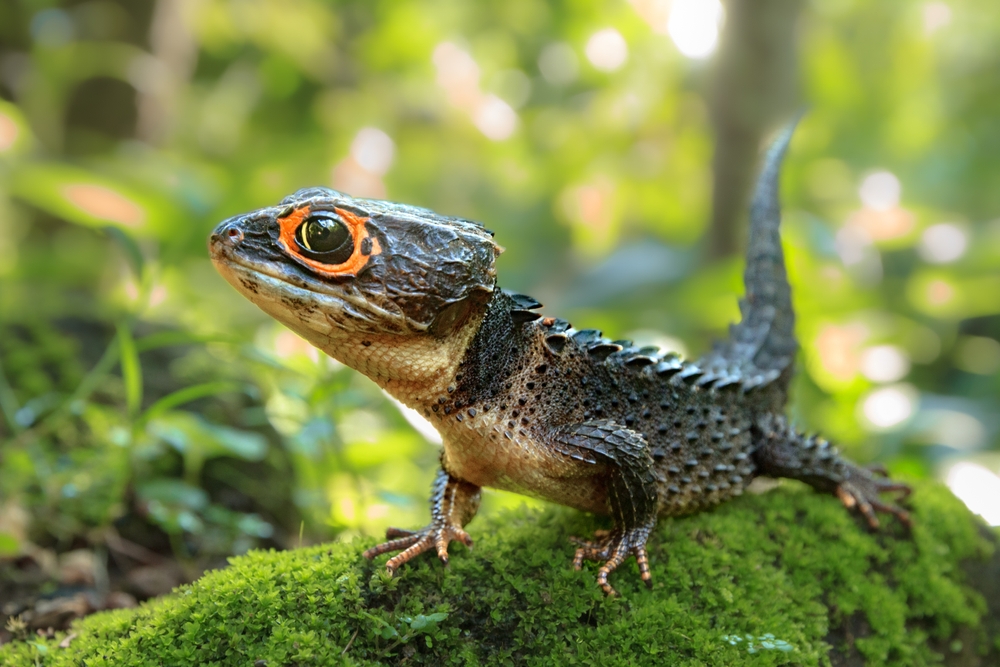Red-eyed crocodile skinks (Tribolonotus gracilis) are small lizards that resemble mini-crocodiles with bright orangey-red eye markings. Despite their enigmatic appearance, they are shy, secretive and often are not comfortable with handling. So, are they the species for you? And what care do they require?
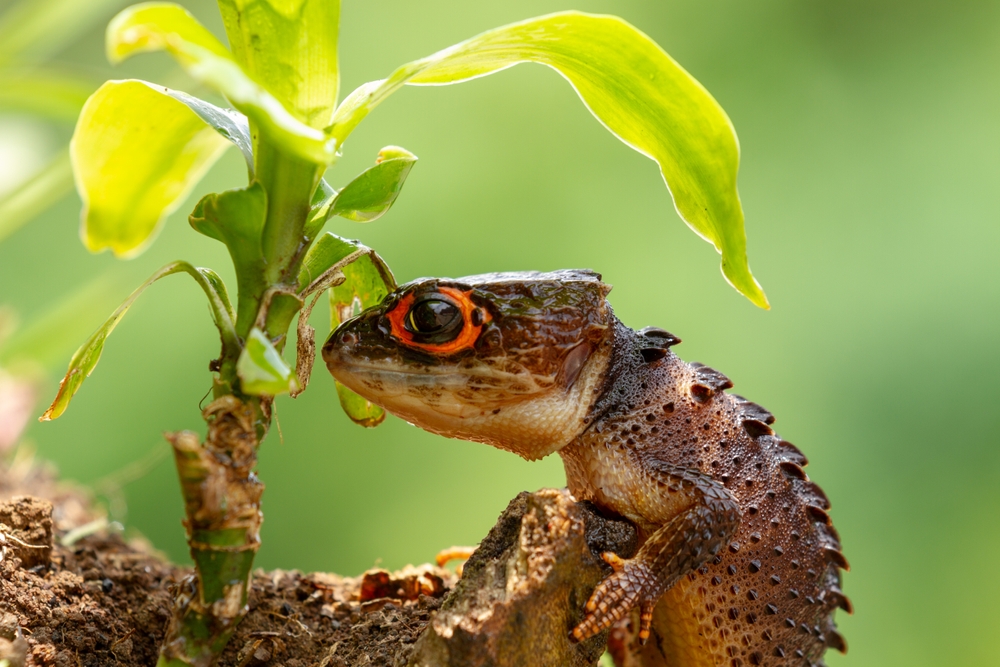
Species Background
Tribolonotus are native to New Guinea, the Bismarck Archipelago and the Solomon Islands. The genus has ten species, with the red-eyed crocodile skink (Tribolonotus gracilis) and the muddy-eyed crocodile skink (Tribolonotus novaeguinea) the most common in captivity.
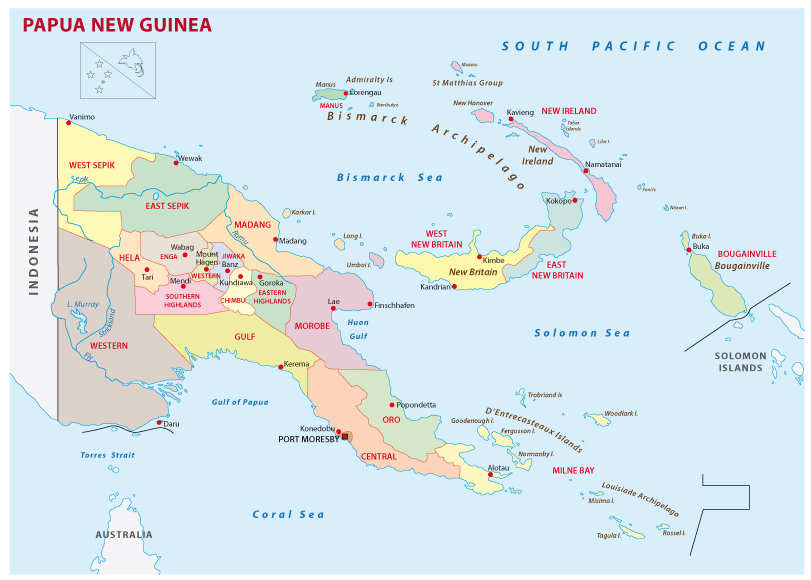
Red-eyed crocodile skinks are crepuscular, verging on nocturnal, being most active at dawn, dusks and periods during the night. Being naturally shy and secretive animals residing in vegetation on the banks of streams, they require densely planted enclosures with large water areas. Consequently, they will be infrequently seen and often require complex and potentially expensive set-ups.
Red-eyed crocodile skinks can grow up to 20 cm in length, with males usually a little larger and stockier than the females. There are no current peer-reviewed scientific journal articles on the lifespan of red-eyed crocodile skinks. However, it has been suggested they can live to 10-14 years in captivity, whilst wild individuals live to ~6 years.
Housing your red-eyed crocodile skink
The goal of the keeper is to provide a slice of the animal’s natural habitat. A well-planted vivarium or paludarium not only enhances visual appeal but plays a vital role in your red-eyed crocodile skink’s health and behaviour. Well planted enclosures maintain high humidity, create microclimates, and provide cover, enrichment, and natural terrain for burrowing and thermoregulation.
The Enclosure
A single red-eyed crocodile skink should be kept in a minimum enclosure size of 60 x 45 x 45 cm, but ideally 90 x 45 x 45 cm. We use the 90 x 45 x 45 ExoTerra. Visual barriers will help them feel secure. As such, it is recommended to cover the sides and back of the enclosure. On the outside this can be achieved with pure black window tint. The interior can be covered with fern bark or cork sheets which provide a climbing surface for plants. More intricate backgrounds can be created with expanding foam, cork flats and driftwood.
The Land
A planted bioactive enclosure with ample substrate depth is ideal for red-eyed crocodile skinks. The substrate needs to be a moisture retaining mix that holds burrows. There are multiple options that fit the bill, with Exo Terra Rainforest substrate and Pro Rep Bio Life Forest substrate representing good options. Providing at least 10 cm of substrate will give your animal plenty of opportunity to burrow. Deeper borrows provide cooler regions and the opportunity to thermoregulate within one burrow. Substrate should be changed periodically, either in its entirety or taking a section of the enclosure at a time.
Semi submerged cork flats and driftwood provide excellent starting burrows for red-eyed crocodile skinks. It is important to provide your skink with multiple hide options across the enclosure to ensure they can bask cryptically across the thermal gradient.
Animals that feel secure in the knowledge there are multiple hides nearby to retreat to are often more confident and bolder. It is worth remembering that ground cover plants and leaf litter will also act as hides, security and variation for your red-eyed crocodile skinks.
Keepers should provide some variation in height within the enclosure. Driftwood, cork and raised mounds can vary the landscape. This allows the skink to regulate their UV intake. It can also make the enclosure appear more natural and aesthetically pleasing.
The Water
Red-eyed crocodile skinks spend significant time in and around water. Providing a large water bowl or designated water section is essential. When using a water bowl, light-coloured bowls containing stagnant water can grow algae at a fast rate if not changed and cleaned every other day.
Having a designated water section has worked better for us. We have done this in two ways. The first was done using an acrylic sheet divider within the tank. The divider was sealed and made to resemble a fallen log using CT1 polymer sealant, expanding foam and cork pieces. The second method used a large Tupperware container submerged into the substrate.

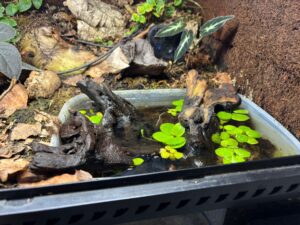
Having a gravel or fluval strata base, driftwood, floating plants and snails, like ramshorn or cone, help create an aquatic ecosystem. It is important to include multiple entry points and refuges to enable your skink to be partially submerged. If the water section is sufficiently large, a small filter pump can be used. When selecting and installing a filter it is important to remember the skink will climb on it given the chance and will track soil and excrement into the water. Enclosing the pump in aquarium eggcrate with a long return tube can be an attractive solution. With clever concealment, a dripwall or waterfall can be created where the pump is accessible. Whether using a pump or not, water changes, removing algae build up and water checks are essential. All water used should be treated to ensure it is reptile safe.
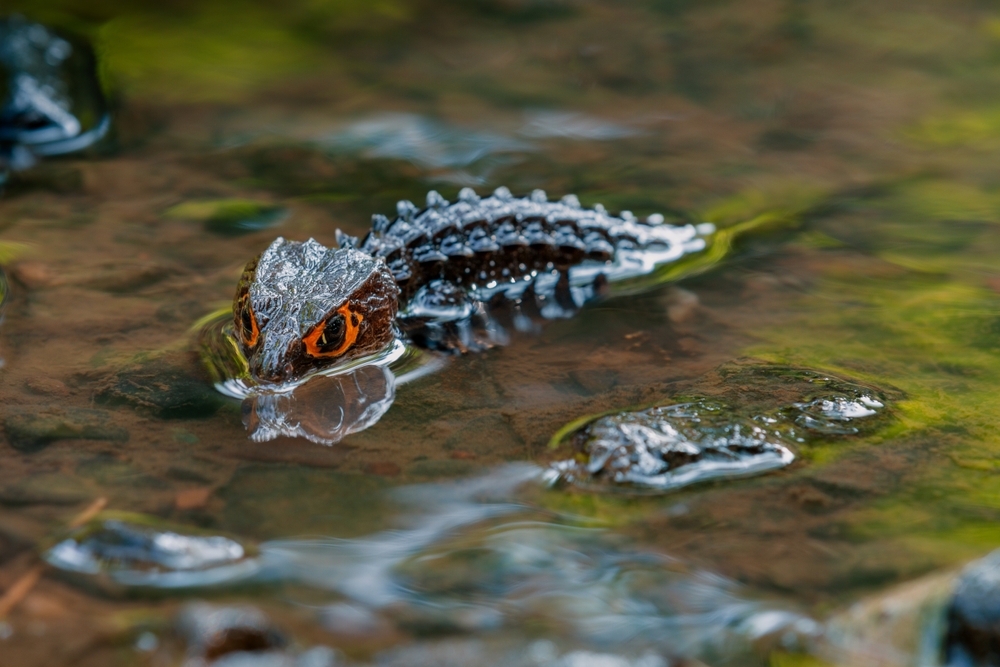
Image of our set-up
Making the Enclosure Bioactive
Red-eyed crocodile skinks thrive in bioactive enclosures. Adding the right flora and microfauna will help make your enclosure a living, breathing home for your animal.
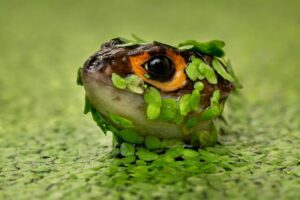
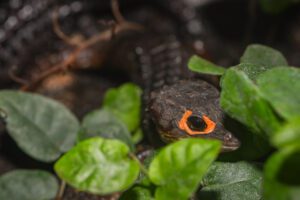
Prioritise plant species that tolerate 80–100% humidity, low to medium light, and consistently moist soil or shallow water. Plants must be non-toxic to reptiles, free of pesticides and fertilisers, and sturdy enough to withstand light digging or the occasional climb from your red-eyed crocodile skinks. The size and how fast the plant grows should also be considered. Your microfauna are the clean-up crew, vital for maintaining a bioactive terrarium. They will recycle organic waste, prevent mould growth, and support nutrient cycling within the substrate.
Choosing the Right Plants for a Tropical Bioactive Setup
Different plants will serve different roles within the enclosure. Terrestrial Plants like ferns are ideal for recreating a tropical forest floor. Species like Asplenium nidus (bird’s nest fern) and Davallia (rabbit’s foot fern) work well but can burn in intense light. Other terrestrial plants provide ground cover with a bit of colour: Peperomia, Pilea, Fittonia, Hypoestes and Gloxinia species are good options. Beautiful, jewelled orchids (Labisia species) and other exotic ornamentals can also work. Trailing and climbing plants spread across soil and hardscape, shading the ground to reduce evaporation and increase humidity. They will also grow on the walls of the enclosure increasing the enclosure’s aesthetic. Ficus, Marcgravi, Selaginella and Syngonium species all work well.
For water features or damp transition zones, opt for semi- or fully aquatic species, such as floaters, Cryptocoryne spp. (water trumpet), Bucephalandra (green wavy), Anubias species, Hydrocotyle spp. (pennywort). These species thrive in shallow water or saturated soils and can be attached to rocks, wood or substrate.
Be aware that some plants may out-grow the enclosure. To avoid this, start with a smaller plant and trim-down plants as needed while still providing ample cover for your animal (don’t worry – they will grow back!). The cuttings can frequently be propagated by placing them in water/soil and bright light, ready to be used in other enclosures. We would caution against using fast growing species like pothos or monstera. Due to their dominance, it is likely your planted jungle will turn into a monoculture and their strong roots can rip foam from the enclosure walls.
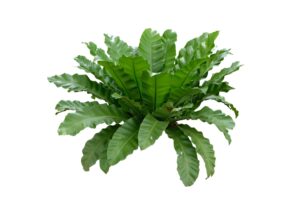
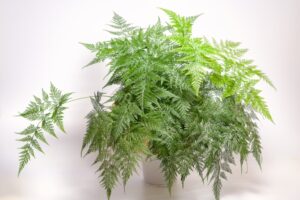
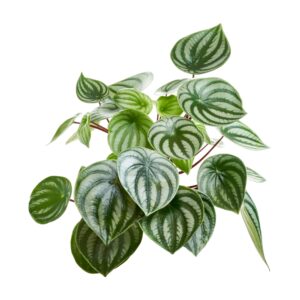
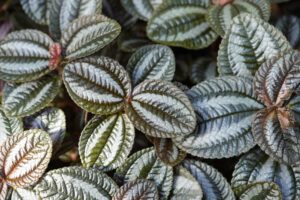
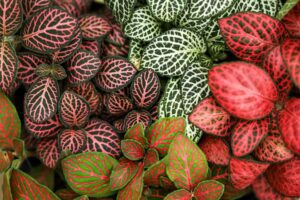
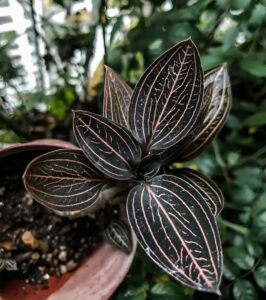
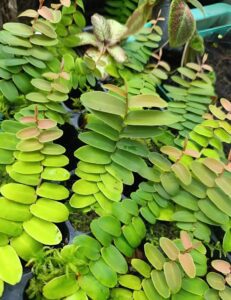
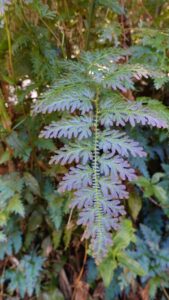
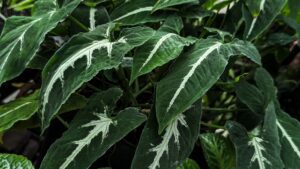
Clean-Up Crew
Springtails and isopods are essential for a good clean-up crew. Springtails (Collembola spp.) feed on fungal hyphae, decaying plant matter and faecal microbe colonies. Found across the world in both tropical and arid environments, springtails are well-adaptable. They will thrive in consistently moist, well-aerated substrates and decomposing organic matter, such as leaf litter and rotting wood.
Accompanying them are isopods – small, non-burrowing terrestrial crustaceans. They will break down leaf litter, faeces, and shed reptile skin. They require high humidity (above 70%), calcium-rich environments for exoskeletal maintenance, and access to both surface detritus and protected microhabitats such as bark crevices. Red-eyed crocodile skinks will predate on appropriately sized isopods. Having dwarf white (Trichorhina tomentosa) and larger Porcellionide species that are topped up every 3-6 months will combat this.
Earthworms (Dendrobaena) and millipedes (Diplopoda) can also be added to maintain the environment but are not essential. These can also easily become a snack for red-eyed crocodile skinks.
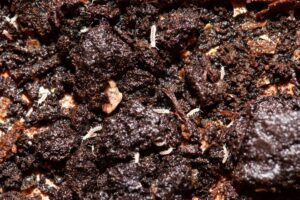
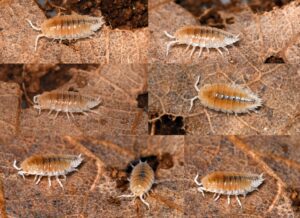


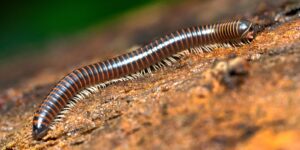
Lighting, Temperatures and Humidity
Red-eyed crocodile skinks require specific lighting. Replicating the full sun spectrum is important for maintaining their natural day/night cycle and cryptic basking behaviours. Creating dawn and dusk environments has become more feasible with the development of new equipment.
Lighting
Red-eyed crocodile skinks are a Ferguson zone 1 to 2 reptile and require a UVI of 1-2. This can be recorded with a solarmeter. The exact bulb you will need to achieve this UVI level, will depend on two things. The first is the distance between the bulb and the highest point of the skink when basking. The second determinant is the length of the enclosure. The UVB bulb should cover ½ to 1/3 of the enclosure and overlap with the heat bulb output. It is best to avoid non-linear bulbs for UVB and stick to T5 bulbs. For a 45 cm tall tank with decent substrate depth, a safe bet would be the Exo Terra UVB 100 T5 3% UVB range.
New technology has made it easier to replicate dawn and dusk for red-eyed crocodile skinks. Using ramping systems to control UV and LED bulb output allows for lower light and UVI periods, matching the day and night cycle. Having the UVI steadily increase to around 2 for midday (or 100% output), be maintained for a couple of hours, and then steadily decrease again is ideal. If using this system, a higher % UVB bulb can be used, e.g. Exo Terra UVB 100 T5 7% UVB range, to better match the day cycle. Alternatively, having the LEDs and UVB bulbs turn on and off at different times can also mimic dawn and dusk.
Heating
To allow your skink to properly thermoregulate, it is important to ensure there is a thermal gradient within the enclosure. A daytime temperature of 26-28oC in the warm end and 23-25oC in the cool end is ideal. If your enclosure drops below 20oC at night, a nighttime heat source may be required. It is important to ensure night heat does not emit light.
For day heat, it is important to have your heat bulb on a thermostat to reduce the chance of the enclosure overheating. Considering red-eyed crocodile skinks require high humidity, the MicroClimate EVO PRO is a good choice. When selecting a bulb for daytime heat, you will want to select the lowest wattage frosted incandescent bulb that will heat the enclosure sufficiently. Choosing the lower wattage will ensure the bulb is on a higher power for longer, meaning the full spectrum of the bulb’s light index is emitted. With this in mind, we recommend either a 25 W or 50 W Reptile Systems Eco Halogen White.
Humidity
Red-eyed crocodile skinks naturally experience high humidity, which should be replicated in captivity. During the day humidity of 75-90 % is ideal, with a slight increase at night to >85 % at night. To increase humidity, the enclosure can be misted manually or through a misting system. We have found using a mixture of both has worked well. Relying primarily on manual spraying ensures you are monitoring your enclosure daily. Whereas the automation of misting systems is essential during times you are away from your red-eyed crocodile skinks. Arguably the best misting system on the market is the MistKing range, especially for multiple enclosures.
Airflow is often overlooked. Stagnant, humid air can lead to numerous issues for red-eyed crocodile skinks and the enclosure ecosystem. Front and top ventilation is essential for airflow. In addition, having one or two computer fans lying on the cool side top ventilation will draw air out of the enclosure through the top ventilation. This causes outside air to be drawn into the enclosure through the front vents. How long and at what intensity the fans need to run will vary from enclosure to enclosure. Having the fans on smart plugs allows schedules to be set and to be turned on remotely if the enclosure starts to overheat or is too humid. Humidity can be tracked using the MicroClimate EVO PRO thermostat.
Diet
Red-eyed crocodile skinks are insectivores, with prey variety being key. Providing as wide a range as possible of insects will help meet your skink’s nutritional needs. As a rule of thumb, each prey item fed should be no bigger than half the size of the skink’s head. The proportion each prey item takes in the skink’s diet should be determined by its nutritional content. Crickets and roach species make a good base diet with earth worms, mealworms, black soldier fly larvae and silkworms adding good variety. Red-eyed crocodile skinks will also predate on clean up crew if they are an appropriate size.
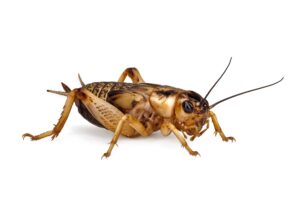
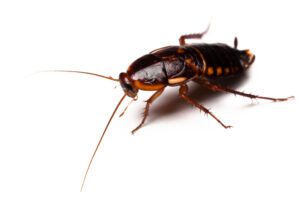
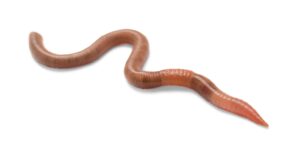
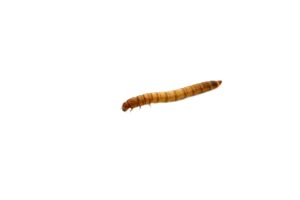
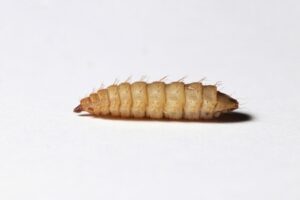
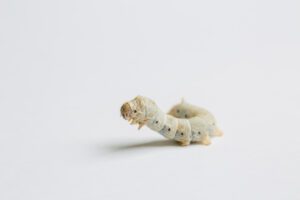
All prey items (feeders) should be gut fed 24-48 hours prior to feeding. Providing feeders a varied and nutritious diet, improves their own nutritional content, giving your skink a better meal. It is also important to supplement your feeders with a dusting of a calcium and multi-vitamin powder to prevent deficiencies. The frequency of supplementation will depend on the product, and you should always check the manufacturers’ recommendations. A favourite of ours to use is Vetark’s Nutrobal. We feed our adult red-eyed crocodile skinks every two to three days, either through adding prey items to the enclosure for natural hunting or tong feeding for socialisation.
Reproduction
Sexing
Sexing red-eyed crocodile skinks involves careful morphological examination, as they exhibit minimal external sexual dimorphism.
Although more difficult to determine, the most reliable characteristic for sex determination is the presence of preanal pores. In sexually mature males (~ over 3-4 years of age), these pores appear as a pair of small, slit-like openings located just anterior to the cloaca. They may exude a waxy secretion and are best observed under magnification. Females lack these pores entirely.
More easily observable, males may exhibit a slightly broader cranial morphology with a head size relatively wider to body. This, however, can vary depending on age, individual variation and nutrition of red-eyed crocodile skinks. Subtle visual difference is also seen on the hind feet, with some males exhibiting slightly raised greyish-blue femoral pores on the underside of the third, fourth, and occasionally fifth digit.
Due to the species being highly stress-sensitive, red-eyed crocodile skinks should be handled gently for a minimum amount of time. If you need to examine your skink, a good way is to place them in a small transparent bottom empty enclosure/aquarium and take an image.
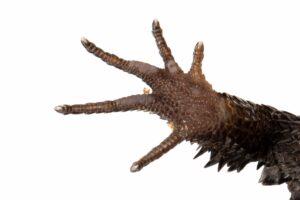
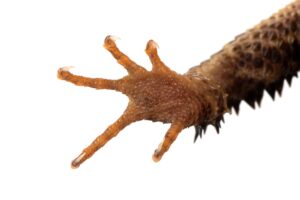
Cohabitation
It is recommended that co-habitation of red-eyed crocodile skinks should only be done with the intent to breed. In a suitably sized enclosure with ample hides, dense leaf cover and separate retreats, a male and female can be kept together with their offspring. As the offspring reach maturity, they will need to be separated from the parents. It is better to introduce the male into the female’s enclosure as he is likely to be larger and capable of showing signs of dominance, such as chasing from hides and occupying prime territory. This gives the female opportunity to familiarise herself with the layout of the enclosure and location of hides to distance herself if necessary. Male and females are not known to form pair bonds or any monogamous attachments. After mating, the male still may show aggressive or chasing behaviour towards the female.
Red-eyed crocodile skinks should always be monitored closely for signs of stress, such as prolonged refusal to feed, weight-loss or any physical trauma. During feeding, offer separate areas as close quarters can lead to one dominating access to resources, often preventing the other one from eating. Do not ignore early signs of aggression, outside of actual breeding, or stress – immediately separate the individuals. It is not recommended to allow two females to co-habit as they may exhibit territorial or aggressive behaviours towards one another, especially during feeding or breeding seasons. Do not house two males together. Males that co-habit are known to show increased aggression, chasing, biting or harassment.
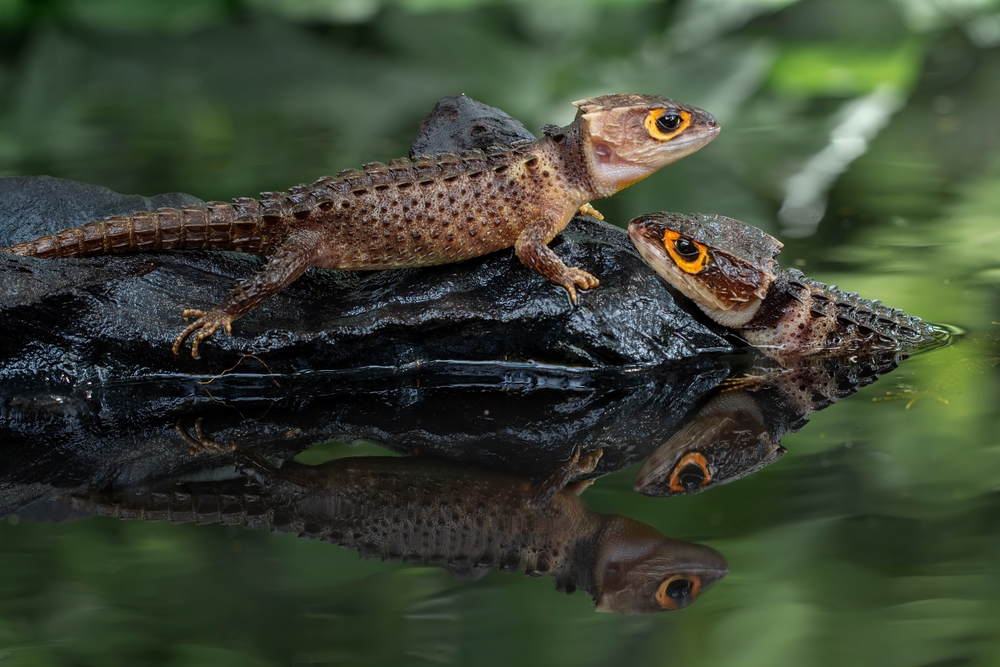
Breeding
Red-eyed crocodile skinks breed in the wet season in their native range and spikes in humidity can trigger breeding behaviour. Male breeding behaviours include head bobbing and throat inflation. Breeding can be rough with the male biting the female’s head and neck during mating. Captive observations seem to indicate that pairs will start breeding if the enclosure is right.
Females will lay one egg at a time, which will take roughly 6 weeks to hatch. Hatching usually coincides with laying of the next egg. Eggs can be incubated within the enclosure, which the parents will guard, or within an incubator. Considering the shyness and the dense plantation in the enclosure, incubation within the enclosure is usually preferred. At times you may not even know you have an egg cooking.
Socialising
Red-eyed crocodile skinks are not particularly handleable. This is especially true with wild caught individuals. Your skink can gain trust with you through time, patience and the correct set-up. To build their trust with you, ‘treat’ prey items can be offered with tongs. Start with dropping the food in front of them. Once your skink is comfortable with this, they may take food directly from the tongs. Finally with patience, you may be able to encourage your skink out into the open with food. It is worth noting that some red-eyed crocodile skinks simply will not ‘tame down’ or ‘brave up’ to the same level as others and it is a long process.
Using outdoor motion detection cameras within the enclosure is a great way to see what your red eyed crocodile skinks are doing while you’re not looking. Through the cameras in our enclosures, we have seen behaviours we could never have seen otherwise.
Conservation Status
The IUCN Red List currently classifies Red-eyed crocodile skinks as “Least Concern” according to the latest assessment using IUCN v3.1. This means that, at present, the species is considered to be at relatively low risk of extinction. Whilst they naturally have a limited geographical range, the overall population is seemingly stable. While the overall population is stable, their exact numbers remain unknown due to the crepuscular and shy nature of the species.
Despite being “Least Concern,” red-eyed crocodile skinks are heavily collected for the exotic pet trade. Most specimens in the trade are still wild-caught and tend to not travel well due to it being a high stress environment. They are sometimes imported with parasites, respiratory infections, or experinece mortality during transit. Some conservationists are concerned that unsustainable collection could lead to declines not yet visible in IUCN assessments where demand outweighs the wild collection of the species.
Red-eyed crocodile skinks are not protected under CITES (the Convention on International Trade in Endangered Species of Wild Fauna and Flora). Their international trade is instead, regulated at national level with quotas applied to export farms in Indonesia. Now, red-eyed crocodile skinks are being bred in good number in situ and ex situ. Under Indonesia’s Captive Breeding Production Plan (CBPP), registered breeding farms can export captive-bred individuals under quotas.
Some studies have shown that under this legislation, some other ‘farms’ production quotas can far exceed biological capacity. Buyers and hobbyists are strongly advised only to purchase genuinely captive-bred individuals and to request proof of captive breeding, such as documentation of clutch records, hatch dates, and lineage. This helps to ensure ethical and responsible sourcing.
By Adam Colyer and Sanya Aggarwal
